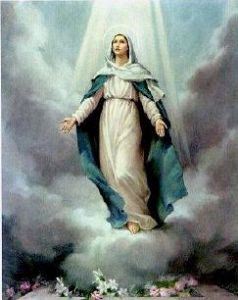|
|
Previous:
St. Mary Joseph Rosello December 7 Next:
St. Juan Diego December 9 Immaculate ConceptionDecember 8 The Blessed Virgin Mary was preserved from the stain of original sin in the first instant of her conception in the womb of her mother. This was a singular privilege and grace of God, granted in view of the merits of Jesus Christ. By her conception is meant not the act or part of her parents in it, nor the formation of her body, nor the conception of Christ later in her own womb; from the moment her soul was created and infused into her body, it was free from original sin and filled with sanctifying grace. Her soul was never stained by original sin, nor by the depraved emotions, passions, and weaknesses consequent on that sin, but created in a state of original sanctity, innocence, and justice. She had at least the graces of the first Eve before the Fall and more. This privilege was befitting the one who was to be mother of the Redeemer.
The Blessed Virgin Mary was preserved from the stain of original sin in the first instant of her conception in the womb of her mother. This was a singular privilege and grace of God, granted in view of the merits of Jesus Christ. By her conception is meant not the act or part of her parents in it, nor the formation of her body, nor the conception of Christ later in her own womb; from the moment her soul was created and infused into her body, it was free from original sin and filled with sanctifying grace. Her soul was never stained by original sin, nor by the depraved emotions, passions, and weaknesses consequent on that sin, but created in a state of original sanctity, innocence, and justice. She had at least the graces of the first Eve before the Fall and more. This privilege was befitting the one who was to be mother of the Redeemer.The doctrine was defined by Blessed Pope Pius IX, 8 December 1854. It is in accord with the texts of Scripture (Genesis 3), "I will put enmities between thee [the serpent] and the woman, and thy seed and her seed"; (Luke 1), "Hail, full of grace." It is established by tradition, by the writings of the Fathers, by feasts observed in honor of this prerogative, by the general belief of the faithful. The very controversies over it among theologians brought about a clear understanding and acceptance of the doctrine long before it was declared by Blessed Pope Pius IX. After the declaration, some Protestant writers denounced what they styled Mariolatry (idolatry of Mary). However, there is a constantly-growing devotion among Catholics, and respect among some Protestant groups for the prerogatives of the Mother of Our Redeemer. Among the many masters who have represented the Immaculate Conception in art are: Carducci, Carreno de Miranda, Falco, Holbein, Montanes, Muller, Murillo, Reni, Ribera, and Signorelli. It is the title she used when appearing at Lourdes. The feast originated in the East about the 8th century where it was celebrated on 9 December. In the Western Church it appeared first in England in the 11th century and was included in the calendar of the universal Church in the 14th century. It has a vigil and an octave, and is a holy day of obligation in the United States, Ireland, and Scotland. Prayer to Mary Immaculate... You are all fair, O Mary; the original stain is not in you. You are the glory of Jerusalem, the joy of Israel, the honor of our people, and the great advocate of sinners. O Mary, Virgin most prudent, Mother most merciful, pray for us; intercede for us with our Lord Jesus Christ. Amen. View All Saints |




